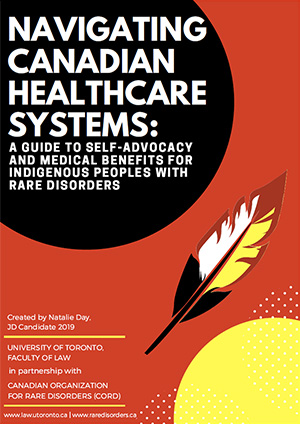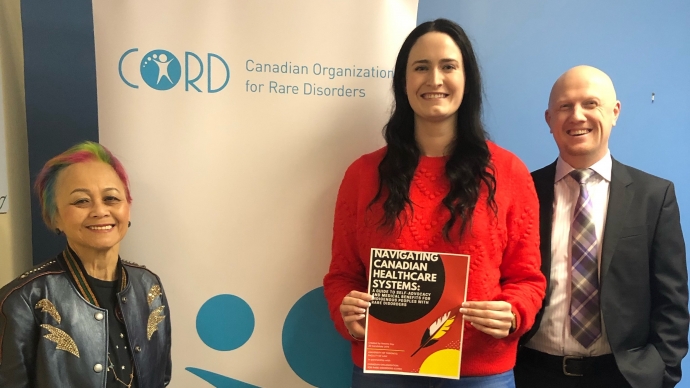The June Callwood Fellowship in Aboriginal Law funded the partnership with the Canadian Organization for Rare Disorders (CORD): Durhane Wong-Rieger, president and CEO of CORD, Natalie Day and Ian Stedman, fellowship supervisor and former CORD board member
By Natalie Day, JD 2019
 I spent last summer working in partnership with the Canadian Organization for Rare Disorders (CORD) to develop a medico-legal guide for Indigenous peoples with rare disorders, thanks to the June Callwood Fellowship in Aboriginal Law. My guide provides information in layperson’s terms on how to navigate the many complex Canadian healthcare systems affecting this patient group, with a particular focus on drug coverage appeals.
I spent last summer working in partnership with the Canadian Organization for Rare Disorders (CORD) to develop a medico-legal guide for Indigenous peoples with rare disorders, thanks to the June Callwood Fellowship in Aboriginal Law. My guide provides information in layperson’s terms on how to navigate the many complex Canadian healthcare systems affecting this patient group, with a particular focus on drug coverage appeals.
I believed Navigating Canadian Healthcare Systems: A Guide to Self-Advocacy and Medical Benefits for Indigenous Peoples with Rare Disorders was necessary to make the healthcare navigation process more accessible and intelligible to Indigenous peoples, especially after my own experience as an Indigenous person with a rare disorder.
I am diagnosed with Narcolepsy Type 2, a chronic, rare sleep disorder.
While there are all kinds of rare disorders, people with rare disorders often share one thing in common—they must become their own health advocates and their own experts. During my undergraduate degree, I experienced increasing daytime sleepiness, sleep paralysis episodes at night, excessive REM sleep during naps and difficulty concentrating. I took a nap every day, sometimes missed early morning classes because I was so tired and if I did attend morning classes, I often struggled to stay awake.
I realized that if someone like myself—someone with privilege, a post-secondary education and access to many resources—was having difficulty navigating the NIHB [Non-Insured Health Benefits] program, I could not imagine what it must be like for people who do not have access to these resources.
I sought help through a family doctor, who ran the usual blood tests for common issues like hypothyroid, anemia or low Vitamin D. All tests came back normal. I later saw a psychiatrist, as I was also struggling with depressive symptoms and anxiety. Once those symptoms were treated, I was still experiencing symptoms that are hallmarks of narcolepsy. I was repeatedly told by my psychiatrist that my anxiety was causing the sleepiness and fatigue. I insisted this was not the case and that it was a physical, not mental, issue.
I did my own research and suspected that narcolepsy could be the cause of my symptoms. I went back to my family doctor and asked for a referral to a sleep clinic. The sleep study results were conclusive—I did in fact have narcolepsy.
My guide was born out of my own experience as a “Status Indian” person with a rare disorder. Under the Non-Insured Health Benefits program (NIHB), which is administered by Indigenous Services Canada, registered First Nations and recognized Inuit persons are eligible for certain medical benefits.
After receiving my diagnosis, I had great difficulty obtaining adequate health services and drug coverage from NIHB. I engaged in the appeals process, which took three months and resulted in NIHB failing to fully evaluate my claim. I decided to abandon any further appeals and worked directly with the drug manufacturer. I was successful in finding an alternative solution that even my sleep specialist was not aware existed.
The NIHB program is extremely convoluted, confusing and lacking any transparency. I realized that if someone like myself—someone with privilege, a post-secondary education and access to many resources—was having difficulty navigating the NIHB program, I could not imagine what it must be like for people who do not have access to these resources.
My frustration with NIHB and the perpetuation of colonial institutions creating barriers for Indigenous peoples informed my research as I prepared this guide. Ultimately, I believe there needs to be systemic transformation of health policies for all Indigenous peoples that gives us autonomy and control over our own health. The federal government is completely detached from how Indigenous peoples know and experience health, and its paternalistic, colonial imposition of euro-centric policies only further exacerbates the poor health of Indigenous peoples and communities.
Until meaningful transformation occurs, I wanted to provide a resource for Indigenous peoples with rare disorders on how to navigate the multiple healthcare systems as they currently exist. My hope is that this guide can ease the navigation process, and help Indigenous peoples maximize the resources currently available to them.
I strongly believe that self-advocacy and being unafraid to openly discuss personal health, both physical and mental, allows us to support one another and contributes to the transformation of ineffective health policies.


 I spent last summer working in partnership with the Canadian Organization for Rare Disorders (CORD) to develop a medico-legal guide for Indigenous peoples with rare disorders, thanks to
I spent last summer working in partnership with the Canadian Organization for Rare Disorders (CORD) to develop a medico-legal guide for Indigenous peoples with rare disorders, thanks to